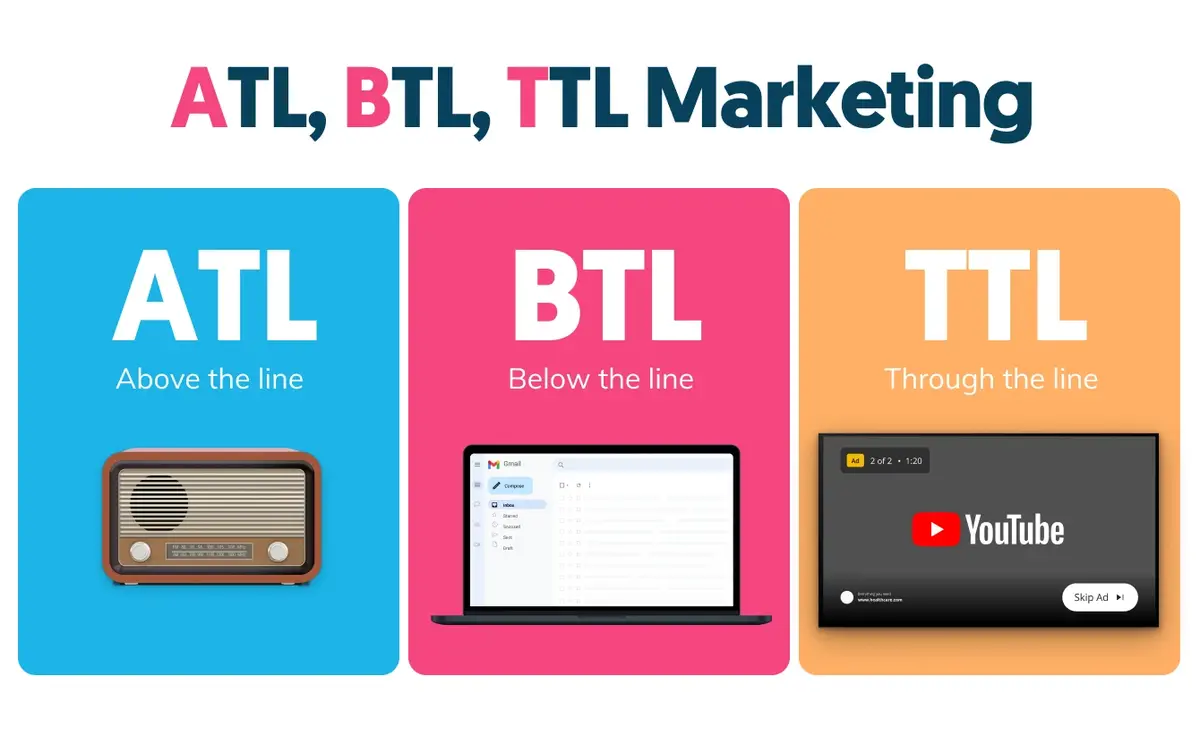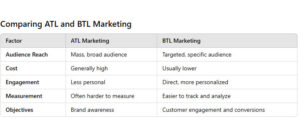In the world of marketing, ATL (Above the Line) and BTL (Below the Line) are two prominent strategies that brands use to connect with audiences. Each approach has unique characteristics and purposes, and choosing the right one depends on the marketing goals and target audience. In this blog, we’ll break down ATL and BTL marketing, their benefits, and how brands can effectively use them.
What is ATL Marketing?
Above the Line (ATL) Marketing refers to mass media advertising that targets a broad audience. Its primary objective is to build brand awareness and reach as many people as possible. ATL marketing is ideal for companies looking to establish a strong brand presence and communicate general messages across a wide demographic.
Characteristics of ATL Marketing
- Broad Reach: Targets a large audience rather than a specific group.
- High Visibility: Ensures that the brand is seen by a wide range of people.
- Higher Costs: ATL campaigns usually require a bigger budget due to the scale of mass media advertising.
Common ATL Marketing Channels
- Television Advertising: Reaches millions of viewers, making it one of the most impactful ATL channels.
- Radio: Engages a wide audience, particularly useful for reaching people during commutes or in local areas.
- Newspapers & Magazines: Reaches readers across regions, suitable for both local and national advertising.
- Billboards: Offers high visibility in public spaces, reaching people on the go.
Benefits of ATL Marketing
- Mass Exposure: Ideal for companies aiming for brand recognition on a large scale.
- Increased Brand Recall: Repetition across various media channels enhances brand recognition.
- Impactful Messaging: Creative ATL campaigns can leave a lasting impression on viewers.
Example of an ATL Campaign
A global brand like Coca-Cola often uses ATL marketing by launching a television ad that airs across multiple countries. The ad promotes a general message that resonates universally, such as a theme of happiness and togetherness.
What is BTL Marketing?
Below the Line (BTL) Marketing focuses on targeted campaigns that engage specific audiences, often leading to immediate conversions. BTL marketing is suitable for companies that aim to communicate directly with consumers, encourage action, and build customer loyalty.
Characteristics of BTL Marketing
- Targeted Audience: Focuses on specific customer groups rather than the general public.
- Personal Engagement: Emphasizes a more personalized approach, often through direct interactions.
- Cost-Effective: Usually more affordable than ATL marketing, as it requires less media spending.
Common BTL Marketing Channels
- Direct Mail: Sends promotional materials directly to potential customers, allowing for a personalized touch.
- Email Marketing: Delivers targeted messages and offers directly to inboxes.
- In-store Promotions: Uses point-of-sale displays, product demos, and sampling to attract customers in stores.
- Social Media: Highly targeted ads on platforms like Instagram or Facebook reach specific demographics based on user interests and behaviors.
Benefits of BTL Marketing
- Higher Engagement: BTL methods foster a closer connection between the brand and the customer.
- Immediate Results: Many BTL strategies, such as sales promotions or product sampling, can lead to instant conversions.
- Enhanced Brand Loyalty: By focusing on personalized experiences, BTL marketing can build strong customer relationships.
Example of a BTL Campaign
A local café might use BTL marketing by hosting a tasting event to introduce a new menu item. Inviting nearby residents or loyal customers creates a direct interaction, encouraging them to try the product and leave feedback, thus creating a personalized brand experience.
When to Use ATL vs. BTL Marketing
- Use ATL Marketing when the goal is to boost brand awareness, introduce a product on a large scale, or reach a broad demographic. This is common for brands launching new products or during peak shopping seasons.
- Use BTL Marketing when aiming to drive specific actions, such as encouraging immediate purchases, nurturing loyalty, or engaging directly with a niche audience.
Useful Links for Further Reading
- What is ATL and BTL Marketing? – Marketing91
- Difference Between ATL, BTL, and TTL Marketing – Business Jargons
- An Introduction to BTL Marketing – Cleverism
Conclusion
ATL and BTL marketing each have unique advantages that can significantly impact a brand’s growth. By understanding the goals of each approach, companies can strategically choose the most suitable marketing techniques for reaching their audience and achieving their objectives. Whether you’re aiming to build broad brand awareness or engage with customers on a personal level, the right mix of ATL and BTL strategies can maximize your brand’s visibility and effectiveness





